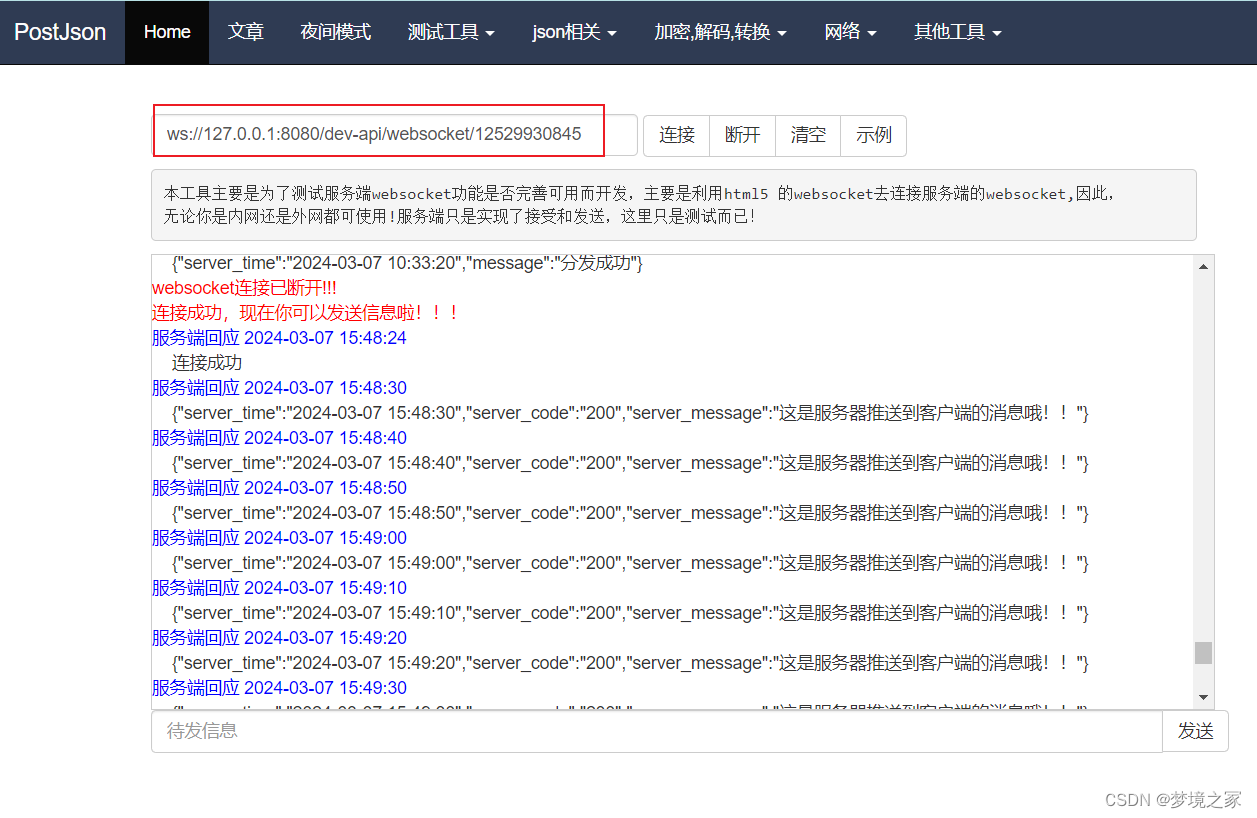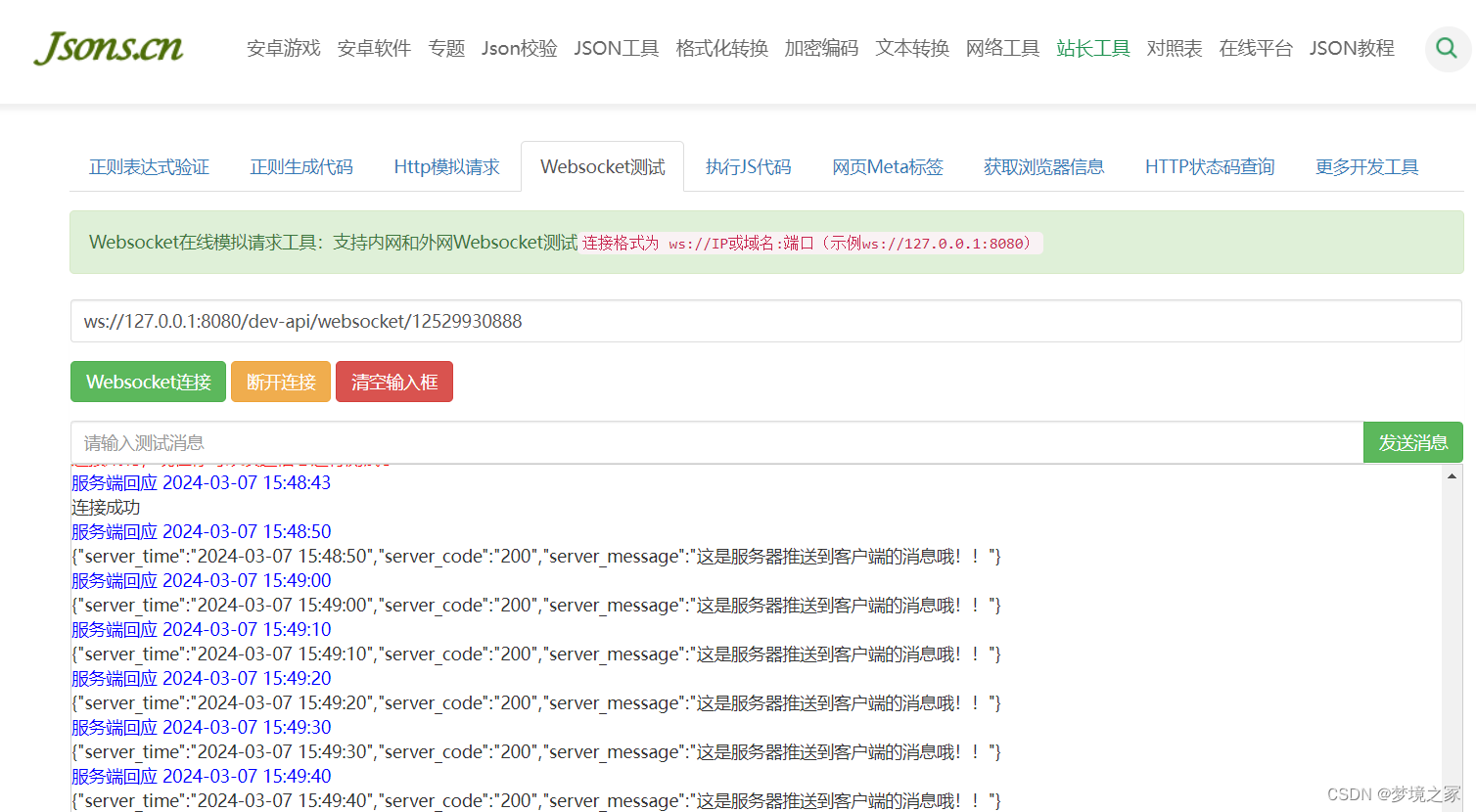
websocket 实现后端主动前端推送数据、及时通讯(vue3 + springboot)
WebSocket 是一种全双工通信协议,用于在 Web 浏览器和服务器之间建立持久的连接。WebSocket 协议由 IETF 定为标准,WebSocket API 由 W3C 定为标准。一旦 Web 客户端与服务器建立连接,之后的全部数据通信都通过这个连接进行。可以互相发送 JSON、XML、HTML 或图片等任意格式的数据。都是基于 TCP 的应用层协议。都使用 Request/Respon
简介
WebSocket 是一种全双工通信协议,用于在 Web 浏览器和服务器之间建立持久的连接。
- WebSocket 协议由 IETF 定为标准,WebSocket API 由 W3C 定为标准。
- 一旦 Web 客户端与服务器建立连接,之后的全部数据通信都通过这个连接进行。
- 可以互相发送 JSON、XML、HTML 或图片等任意格式的数据。
WebSocket 与 HTTP 协议的异同:
相同点:
- 都是基于 TCP 的应用层协议。
- 都使用 Request/Response 模型进行连接的建立。
- 可以在网络中传输数据。
不同点:
- WebSocket 使用 HTTP 来建立连接,但定义了一系列新的 header 域,这些域在 HTTP 中并不会使用。
- WebSocket 支持持久连接,而 HTTP 协议不支持持久连接。
WebSocket 优点:
高效性: 允许在一条 WebSocket 连接上同时并发多个请求,避免了传统 HTTP 请求的多个 TCP 连接。
WebSocket 的长连接特性提高了效率,避免了 TCP 慢启动和连接握手的开销。
节省带宽:HTTP 协议的头部较大,且请求中的大部分头部内容是重复的。WebSocket 复用长连接,避免了这一问题。
服务器推送:WebSocket 支持服务器主动推送消息,实现实时消息通知。
WebSocket 缺点:
长期维护成本:服务器需要维护长连接,成本较高。
浏览器兼容性:不同浏览器对 WebSocket 的支持程度不一致。
受网络限制:WebSocket 是长连接,受网络限制较大,需要处理好重连。
WebSocket 应用场景:
- 实时通信领域:
- 社交聊天弹幕
- 多玩家游戏
- 协同编辑
- 股票基金实时报价
- 体育实况更新
- 视频会议/聊天
- 基于位置的应用
- 在线教育
- 智能家居等需要高实时性的场景。
一、后端代码
1、安装核心jar包: spring-boot-starter-websocket
<dependencies>
<!-- SpringBoot Websocket -->
<dependency>
<groupId>org.springframework.boot</groupId>
<artifactId>spring-boot-starter-websocket</artifactId>
</dependency>
<dependency>
<groupId>cn.hutool</groupId>
<artifactId>hutool-all</artifactId>
<version>5.1.0</version>
</dependency>
<dependency>
<groupId>com.alibaba</groupId>
<artifactId>fastjson</artifactId>
<version>2.0.22</version>
</dependency>
</dependencies>
2. 来一个配置类注入
package com.codeSE.config;
import org.springframework.context.annotation.Bean;
import org.springframework.context.annotation.Configuration;
import org.springframework.web.socket.server.standard.ServerEndpointExporter;
@Configuration
public class WebSocketConfig2 {
@Bean
public ServerEndpointExporter serverEndpointExporter(){
return new ServerEndpointExporter();
}
}
3. 写个基础webSocket服务
import cn.hutool.log.Log;
import cn.hutool.log.LogFactory;
import com.alibaba.fastjson.JSON;
import com.alibaba.fastjson.JSONObject;
//import org.apache.commons.lang3.StringUtils;
import org.springframework.stereotype.Component;
import org.springframework.util.StringUtils;
import javax.websocket.*;
import javax.websocket.server.PathParam;
import javax.websocket.server.ServerEndpoint;
import java.io.IOException;
import java.util.concurrent.ConcurrentHashMap;
/**
* @ClassName: 开启WebSocket支持
*/
@ServerEndpoint("/dev-api/websocket/{userId}")
@Component
public class WebSocketServer {
static Log log = LogFactory.get(WebSocketServer.class);
/**
* 静态变量,用来记录当前在线连接数。应该把它设计成线程安全的。
*/
private static int onlineCount = 0;
/**
* concurrent包的线程安全Set,用来存放每个客户端对应的MyWebSocket对象。
*/
private static ConcurrentHashMap<String, WebSocketServer> webSocketMap = new ConcurrentHashMap<>();
/**
* 与某个客户端的连接会话,需要通过它来给客户端发送数据
*/
private Session session;
/**
* 接收userId
*/
private String userId = "";
/**
* 连接建立成功调用的方法
*/
@OnOpen
public void onOpen(Session session, @PathParam("userId") String userId) {
this.session = session;
this.userId = userId;
if (webSocketMap.containsKey(userId)) {
webSocketMap.remove(userId);
webSocketMap.put(userId, this);
//加入set中
} else {
webSocketMap.put(userId, this);
//加入set中
addOnlineCount();
//在线数加1
}
log.info("用户连接:" + userId + ",当前在线人数为:" + getOnlineCount());
try {
sendMessage("连接成功");
} catch (IOException e) {
log.error("用户:" + userId + ",网络异常!!!!!!");
}
}
/**
* 连接关闭调用的方法
*/
@OnClose
public void onClose() {
if (webSocketMap.containsKey(userId)) {
webSocketMap.remove(userId);
//从set中删除
subOnlineCount();
}
log.info("用户退出:" + userId + ",当前在线人数为:" + getOnlineCount());
}
/**
* 收到客户端消息后调用的方法
*
* @param message 客户端发送过来的消息
*/
@OnMessage
public void onMessage(String message, Session session) {
log.info("用户消息:" + userId + ",报文:" + message);
//可以群发消息
//消息保存到数据库、redis
if (! StringUtils.isEmpty(message)) {
try {
//解析发送的报文
JSONObject jsonObject = JSON.parseObject(message);
} catch (Exception e) {
e.printStackTrace();
}
}
}
/**
* @param session
* @param error
*/
@OnError
public void onError(Session session, Throwable error) {
log.error("用户错误:" + this.userId + ",原因:" + error.getMessage());
error.printStackTrace();
}
/**
* 实现服务器主动推送
*/
public void sendMessage(String message) throws IOException {
this.session.getBasicRemote().sendText(message);
}
/**
* 实现服务器主动推送
*/
public static void sendAllMessage(String message) throws IOException {
ConcurrentHashMap.KeySetView<String, WebSocketServer> userIds = webSocketMap.keySet();
for (String userId : userIds) {
WebSocketServer webSocketServer = webSocketMap.get(userId);
webSocketServer.session.getBasicRemote().sendText(message);
System.out.println("webSocket实现服务器主动推送成功userIds====" + userIds);
}
}
/**
* 发送自定义消息
*/
public static void sendInfo(String message, @PathParam("userId") String userId) throws IOException {
log.info("发送消息到:" + userId + ",报文:" + message);
if (!StringUtils.isEmpty(message) && webSocketMap.containsKey(userId)) {
webSocketMap.get(userId).sendMessage(message);
} else {
log.error("用户" + userId + ",不在线!");
}
}
public static synchronized int getOnlineCount() {
return onlineCount;
}
public static synchronized void addOnlineCount() {
WebSocketServer.onlineCount++;
}
public static synchronized void subOnlineCount() {
WebSocketServer.onlineCount--;
}
}
4. 写一个测试类,定时向客户端推送数据或者可以发起请求推送
package com.codeSE.controller;
import com.alibaba.fastjson2.JSONObject;
import com.codeSE.config.WebSocketServer;
import org.springframework.scheduling.annotation.Scheduled;
import org.springframework.web.bind.annotation.PostMapping;
import org.springframework.web.bind.annotation.RequestMapping;
import org.springframework.web.bind.annotation.RestController;
import java.time.LocalDateTime;
import java.time.format.DateTimeFormatter;
import java.util.HashMap;
import java.util.Map;
@RestController
@RequestMapping("/money")
public class Test {
//设置定时十秒一次
@Scheduled(cron = "0/10 * * * * ?")
@PostMapping("/send")
public String sendMessage() throws Exception {
Map<String,Object> map = new HashMap<>();
// 获取当前日期和时间
LocalDateTime nowDateTime = LocalDateTime.now();
DateTimeFormatter dateTimeFormatter = DateTimeFormatter.ofPattern("yyyy-MM-dd HH:mm:ss");
System.out.println(dateTimeFormatter.format(nowDateTime));
map.put("server_time",dateTimeFormatter.format(nowDateTime));
map.put("server_code","200");
map.put("server_message","这是服务器推送到客户端的消息哦!!");
JSONObject jsonObject = new JSONObject(map);
WebSocketServer.sendAllMessage(jsonObject.toString());
return jsonObject.toString();
}
}
5. 启动springboot
package com.codeSE;
import org.springframework.boot.SpringApplication;
import org.springframework.boot.autoconfigure.SpringBootApplication;
import org.springframework.boot.web.servlet.ServletComponentScan;
import org.springframework.scheduling.annotation.EnableScheduling;
@EnableScheduling //定时任务
@ServletComponentScan //webSocket
@SpringBootApplication
public class WebSocketAppMain {
public static void main(String[] args) {
SpringApplication.run(WebSocketAppMain.class);
}
}
使用网上的测试工具试一下:http://coolaf.com/tool/chattest 或者http://www.jsons.cn/websocket/
效果如下:


二、前端代码
使用vue3和原生websocket
1、简单写一个websocket的公共类
需求:commentUtil/WebsocketTool.js
//需求:在JavaScript中实现WebSocket连接失败后3分钟内尝试重连3次的功能,你可以设置一个重连策略,
// 包括重连的间隔时间、尝试次数以及总时间限制。
/**
* @param {string} url Url to connect
* @param {number} maxReconnectAttempts Maximum number of times
* @param {number} reconnect Timeout
* @param {number} reconnectTimeout Timeout
*
*/
class WebSocketReconnect {
constructor(url, maxReconnectAttempts = 3, reconnectInterval = 20000, maxReconnectTime = 180000) {
this.url = url
this.maxReconnectAttempts = maxReconnectAttempts
this.reconnectInterval = reconnectInterval
this.maxReconnectTime = maxReconnectTime
this.reconnectCount = 0
this.reconnectTimeout = null
this.startTime = null
this.socket = null
this.connect()
}
//连接操作
connect() {
console.log('connecting...')
this.socket = new WebSocket(this.url)
//连接成功建立的回调方法
this.socket.onopen = () => {
console.log('WebSocket Connection Opened!')
this.clearReconnectTimeout()
this.reconnectCount = 0
}
//连接关闭的回调方法
this.socket.onclose = (event) => {
console.log('WebSocket Connection Closed:', event)
this.handleClose()
}
//连接发生错误的回调方法
this.socket.onerror = (error) => {
console.error('WebSocket Connection Error:', error)
this.handleClose() //重连
}
}
//断线重连操作
handleClose() {
if (this.reconnectCount < this.maxReconnectAttempts && (this.startTime === null ||
Date.now() - this.startTime < this.maxReconnectTime)) {
this.reconnectCount++
console.log(`正在尝试重连 (${this.reconnectCount}/${this.maxReconnectAttempts})次...`)
this.reconnectTimeout = setTimeout(() => {
this.connect()
}, this.reconnectInterval)
if (this.startTime === null) {
this.startTime = Date.now()
}
} else {
console.log('超过最大重连次数或重连时间超时,已放弃连接!Max reconnect attempts reached or exceeded max reconnect time. Giving up.')
this.reconnectCount = 0 // 重置连接次数0
this.startTime = null // 重置开始时间
}
}
//清除重连定时器
clearReconnectTimeout() {
if (this.reconnectTimeout) {
clearTimeout(this.reconnectTimeout)
this.reconnectTimeout = null
}
}
//关闭连接
close() {
if (this.socket && this.socket.readyState === WebSocket.OPEN) {
this.socket.close()
}
this.clearReconnectTimeout()
this.reconnectCount = 0
this.startTime = null
}
}
// WebSocketReconnect 类封装了WebSocket的连接、重连逻辑。
// maxReconnectAttempts 是最大重连尝试次数。
// reconnectInterval 是每次重连尝试之间的间隔时间。
// maxReconnectTime 是总的重连时间限制,超过这个时间后不再尝试重连。
// reconnectCount 用于记录已经尝试的重连次数。
// startTime 用于记录开始重连的时间。
// connect 方法用于建立WebSocket连接,并设置相应的事件监听器。
// handleClose 方法在WebSocket连接关闭或发生错误时被调用,根据条件决定是否尝试重连。
// clearReconnectTimeout 方法用于清除之前设置的重连定时器。
// close 方法用于关闭WebSocket连接,并清除重连相关的状态。
// 使用示例
// const webSocketReconnect = new WebSocketReconnect('ws://your-websocket-url')
// 当不再需要WebSocket连接时,可以调用close方法
// webSocketReconnect.close();
export default WebSocketReconnect
2、在任意Vue页面
<template>
<div>
<el-input v-model="textarea1" :rows="5" type="textarea" placeholder="请输入" />
</div>
</template>
<script setup>
import { ref, reactive,, onMounted, onUnmounted } from 'vue'
import WebSocketReconnect from '@/commentUtil/WebsocketTool'
// --------------------------------------------
let textarea1 = ref('【消息】---->')
let websocket = null
//判断当前浏览器是否支持WebSocket
if ('WebSocket' in window) {
//连接WebSocket节点
websocket = new WebSocketReconnect('ws://127.0.0.1:8080' + '/dev-api/websocket/1122334455')
} else {
alert('浏览器不支持webSocket')
}
//接收到消息的回调方法
websocket.socket.onmessage = function (event) {
let data = event.data
console.log('后端传递的数据:' + data)
//将后端传递的数据渲染至页面
textarea1.value = textarea1.value + data + '\n' + '【消息】---->'
}
//监听窗口关闭事件,当窗口关闭时,主动去关闭websocket连接,防止连接还没断开就关闭窗口,server端会抛异常。
window.onbeforeunload = function () {
websocket.close()
}
//关闭连接
function closeWebSocket() {
websocket.close()
}
//发送消息
function send() {
websocket.socket.send({ kk: 123 })
}
//------------------------------------
</script>
<style scoped>
</style>
效果:

更多推荐
 已为社区贡献1条内容
已为社区贡献1条内容








所有评论(0)